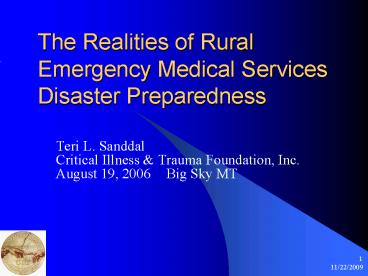The Realities of Rural Emergency Medical Services Disaster Preparedness - PowerPoint PPT Presentation
1 / 24
Title:
The Realities of Rural Emergency Medical Services Disaster Preparedness
Description:
Rural zip codes according to USDA. FEMA Regions 3 and 8. Region 3; PA, MD, VA, WV ... Prehospital, hospitals, public healthcare must address surge capacity ... – PowerPoint PPT presentation
Number of Views:53
Avg rating:3.0/5.0
Title: The Realities of Rural Emergency Medical Services Disaster Preparedness
1
The Realities of Rural Emergency Medical Services
Disaster Preparedness
- Teri L. Sanddal
- Critical Illness Trauma Foundation, Inc.
- August 19, 2006 Big Sky MT
2
Other Authors
- Paul M. Furbee
- Jeffery H. Coben
- Sharon K. Smyth
- William G. Manley
- Daniel E. Summers
- Nels D. Sanddal
- James C. Helmkamp
- Rodney L. Kimble
- Ronald C. Althouse
- Aaron T. Kocsis
3
Funding
- Funded by Department of Health and Human
Services, Health Resources and Services
Administration - Grant 1D1ARH00981
4
Disaster Planning???????
Plan
Plan
Plan
Plan
Plan
Plan
Plan
Plan
Plan
Plan
Plan
Plan
5
Introduction
- Emergency healthcare is not prepared for
disasters, either terrorist or natural - Emergency medical services will be among the
first to respond in the event of MCI - No standard that requires EMS to have a disaster
plan - Few studies have addressed the preparedness of
rural EMS organizations
6
Purpose
- To assess the attitudes and experiences of rural
EMS organizations regarding emergency
preparedness and responses to multi-casualty
events.
7
Survey Instrument
- West Virginia IRB
- Mailed to EMS Agency's Training Officer
- With terminology page
- Designed by team of Subject Matter Experts
- Likert scale 1 to 5
- 1 very prepared
- 5 very unprepared
8
Methods
- Mailed written survey
- Rural zip codes according to USDA
- FEMA Regions 3 and 8
- Region 3 PA, MD, VA, WV
- Region 8 MT, ND, SD, WY, UT, CO
- 4 Western States
- NV, AZ, NM, ID
9
Participants
- 34 Rural counties
- 1,815 EMS agencies
10
Survey Questions
- Agency self-assessment of preparedness
- Actual experience with and participation in
disaster response - Expenditure of time and money for disaster
training - Training activities completed
- Rate level of preparedness
- Organizational characteristics
11
Results --
- Final response rate 43
- 768/1801
- 14 addresses undeliverable
12
(No Transcript)
13
Results Surge Capacity Number of Patients
14
Results Perceived Response Capabilities
- Confident dealing with
- Cardiac emergencies
- Motor vehicle trauma
- Less confident and prepared for
- Victims of chemical weapons
15
(No Transcript)
16
Results EMS ExperienceIn the past 2 years
- 293 (38) had MCI that overwhelmed
- 186 (24) Disaster plan invoked
- 200 (26) Assisted with State declared disaster
- 27 (4) Worked with DMAT
- 25 (3) Worked with CST
- 65 (8) Worked with CERT
17
Results Training Activities
- Over 220 of increased training was
- Structural collapse
- Terrorism
- Other areas of increased emphasis
- Respond to infectious disease outbreaks
- Explosions, riots, earthquakes, and bombings
- Decreased training
- In all areas other than disaster
- Structure Fire 74
18
(No Transcript)
19
Results Training Priorities
- Rank top 5 priorities
- Ability to attract and retain personnel
- Preparedness to respond to common MCI events
- Ability to communicate with other responders
- Areas of improvement least important
- Ability to recognize expose to radiological
contaminations - Interaction and relationship with local health
departments
20
(No Transcript)
21
If You Were Given 100K for Training
22
Discussion
- Realities of rural EMS
- Limited resources
- Limited surge capacities
- Limited abilities to response to mass casualty
- Limited/no abilities to response to large urban
populations displaced.
23
Discussion
- Most important
- Maintaining an all hazards approach to disaster
recognition, containment and response - Improve inter-agency communication skills and
capabilities - Increase involvement in regional planning, that
include roles, and responsibilities of EMS with
others
24
Conclusion
- Rural EMS discover how to maintain adequate and
sustainable training levels - Train for an all hazards instead of specific
threats - Training should focus on common elements in
disaster - Communications
- Command and control and inter-agency cooperation.
- Prehospital, hospitals, public healthcare must
address surge capacity - MUST prepare together not in isolation































